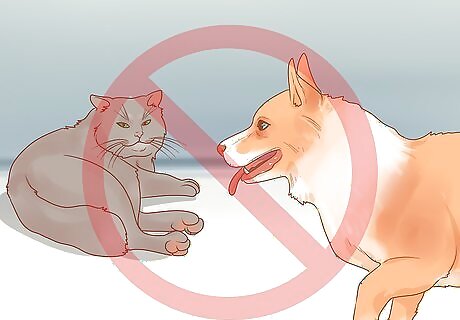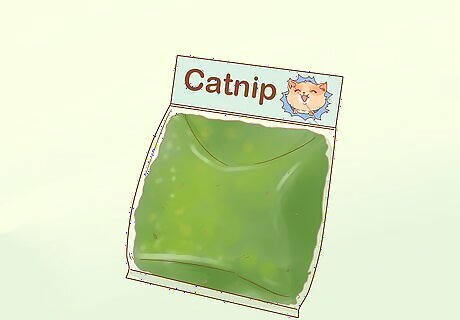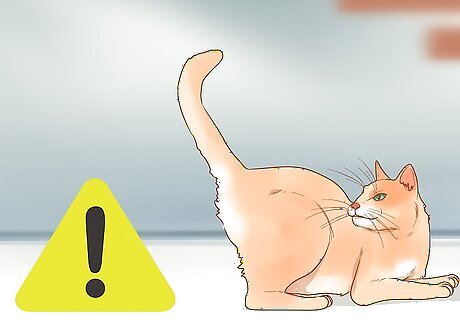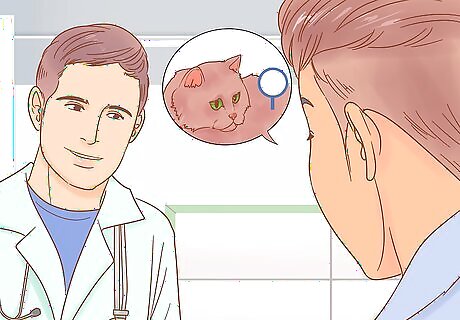
views
Giving Your Cat Its Own Space

Get a cat tree. A cat tree will provide your cat a safe haven from the attentions of your dog. Cats often attack dogs to get the dog to leave them alone, so providing a spot where your cat can nap in peace is essential for maintaing good pet relations. Place the cat tree in an area that is often frequented by both pets so that the cat can choose to climb to its hiding spot instead of attacking the dog. Make sure that the dog can’t get to the cat when it’s in the cat tree.

Set up a baby gate. Cats can easily leap over a baby gate, but most dogs can’t. Use a baby gate to allow your cat to separate itself from your dog. If the dog is bothering the cat, then the cat can leap over the gate and ignore the dog rather than scratching or hissing at the dog to get it to go away. You can also find baby gates with small holes in the bottom that would allow your cat to crawl through, but don’t choose this option if your dog is small enough to follow.

Provide a high perch for your cat. If you have a high windowsill or a piece of furniture that your cat likes, encourage your cat to use it by rubbing it with catnip. Alternatively, if it’s large enough, put a cat bed on it. You can also install a sturdy corner shelf for your cat to use as a perch.

Create a separate area for each pet’s food and belongings. Both cats and dogs can be territorial over food bowls, toys, and the litterbox. Make sure that each pet has its own special area so that the two don’t get into scuffles over whose food bowl is whose. Additionally, keep your dog away from your cat’s litterbox. Keep your cat’s food and water out of your dog’s reach as well to avoid conflict.

Keep your cat and dog separate. As long as the attacks are an issue, don’t leave your cat and dog alone unattended. Your cat can seriously injure your dog by scratching its eye or causing an infection. Cat bites are especially prone to infection. You’re also risking your cat’s safety since the dog has every reason to fight back in defense. Consider locking your pets in different rooms, particularly if you are going to be away from home. Make sure that each pet has the supplies it needs, something to stimulate it, and a comfortable place to lay.
Providing Appropriate Options For Play

Give your cat a new toy. Cats are natural hunters and need to release their aggression. Sometimes cats choose to do that by attacking other pets or their owners. Prevent that reaction in your cat by giving them toys that allow them to chase and attack in a safe way. The novelty of the new toy should entice your cat. It may have become bored with its old toys, leading it to choose your dog as a plaything instead.

Choose playthings that have feathers. Since your cat needs to chase and attack, feathered toys are a great option to stimulate and release those urges. If your cat has a particular affinity for your dog’s tail, then toys with feathers can help divert that urge. Toys with strings or ribbons are not advisable, as your cat can accidentally swallow the string. This can cause intestinal obstructions or other internal damage.

Use catnip to make the toys irresistible to your cat. If your cat has plenty of toys but still likes to pounce on the dog instead, try rubbing the toys with catnip. The catnip will draw your cat to the toys instead of your dog. Rub a few toys at a time with catnip to avoid overwhelming your cat. Make sure that you wash your hands after using catnip; otherwise, you may accidentally rub catnip onto the dog.

Make sure your cat has opportunities for exercise. Cats need to run and play, so help your cat work off its aggression by getting in plenty of activity. Play interactive games with your cat with a feathered toy or laser pointer. Get your cat toys that allow it to chase, such as electronic mice. Provide your cat with a cat tower that allows it to climb.

Address redirected aggression. Some cats naturally have their innate hunter triggered by watching the outside world. If your cat becomes worked up by experiences like watching birds outside, then you may need to block out the windows with curtains, blinds, or even taped on window covers, such as newspaper or foil. Keep your cat away from your dog while it’s struggling with redirected aggression. During this time, you may also be vulnerable to scratches or bites.
Helping Your Cat Calm Down

Spend quality time with your cat. Petting or playing with your cat can have a calming effect and can help eliminate feelings of jealousy in your cat. It’s especially important to spend plenty of time with your cat if your dog is new. Provide your cat with the type of attention it likes. Not all cats like to be petted, so do what your cat enjoys.

Try over-the-counter products for calming cats. Your cat may be attacking your dog because it’s stressed, especially if the dog is new to your home. You can buy a Feliway plug-in or chewy snacks called Composure soft-chews that are designed to help anxious cats calm down.

Train your dog if it’s contributing to the situation. Sometimes cats attack dogs because the dog is playing rough or acting aggressively toward the cat. If your dog is an equal or partial partner in the attacks from your cat, then you may need to train your dog how to act toward your cat. This will help both pets better spend time together. Try training tips from the internet. Consider taking your dog to a dog trainer. Ask your vet for recommendations.

Know how to stop a fight. If your cat and dog get into a fight, you’ll need to get them to stop. First try creating a loud noise that startles the animals, which will allow one of them to escape or may allow you time to grab one. You can also try spraying your pets with water or throwing a blanket over them. Avoid yelling, as this can agitate your pets and encourage them to keep fighting. Don’t get in between the two animals.

Spay or neuter your pets. Spaying and neutering will reduce aggression in your pets and make them less likely to antagonize each other.

Use time-outs. When one of your pets starts messing with the other, tell them “no,” pick up your pet, and place them in a separate location like a bathroom. Leave them in time out for 5-10 minutes. When you let them out, treat the pet as though nothing happened.

Take your cat to the vet. If your cat and dog have been getting along but your cat suddenly begins attacking your dog, then the cat may be ill. A sick cat can react aggressively when it’s messed with, even if it normally wouldn’t behave that way. The vet can rule out illness as a cause for your cat’s attacks on your dog.
Reinforcing Good Behavior

Give your cat treats when it reacts appropriately. When your cat interacts well with your dog or does not aggressively hiss or swipe at it, give it a treat to reward it. The treats should teach your cat to behave well with your dog.

Pet your cat or show it attention when it ignores the dog or plays well. Positively reinforce good behavior by giving your cat special attention, such as petting or extra play. This can work especially well for older cats that don’t like being bothered by a playful dog. When your cat doesn’t bat the dog to get it to go away, you can show it that you approve by speaking to the cat and petting it.

Don’t lavish attention on your cat when it behaves aggressively. When cats hiss or react fearfully to a dog, it’s normal to want to scoop them up and pet them so that they’ll calm down. While it may work to get your kitty calm, it also teaches your cat to attack the dog when it wants attention. While you want your cat to feel safe, make sure that you aren’t rewarding it for undesirable behavior. Be firm when you remove the cat from the situation, and then let the cat sit alone for a few minutes before showing it positive attention. Never physically punish your cat.




















Comments
0 comment